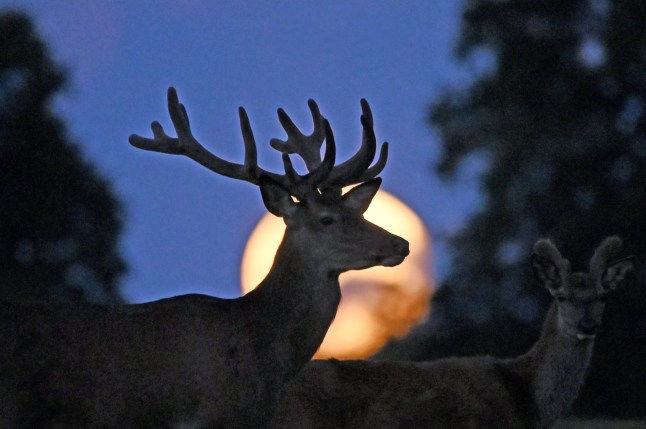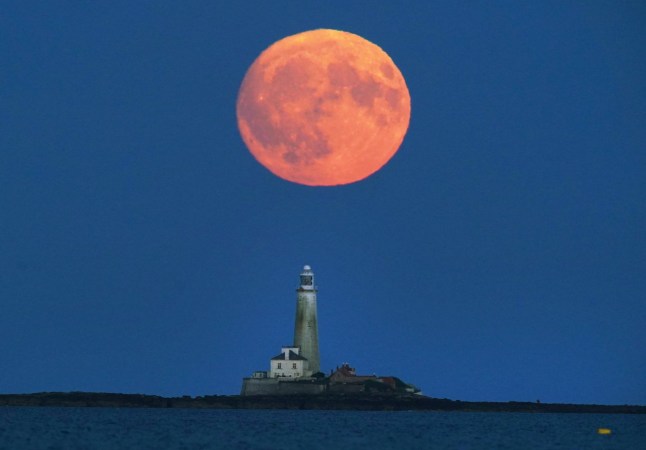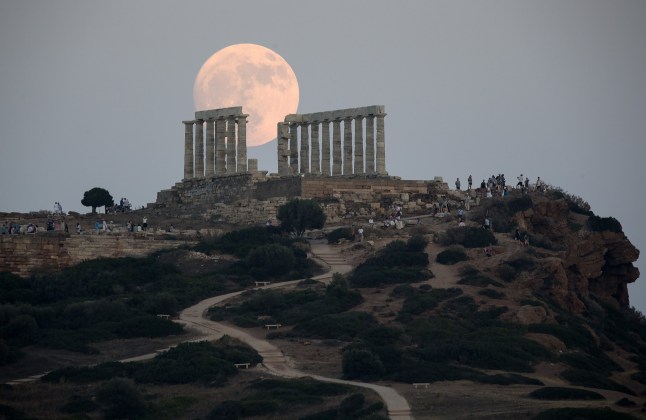
The ‘Buck Moon’ seen north of Copenhagen on July 14,2022 (Picture: Getty)
Look to the skies on Thursday night and you can see something unusual: the ‘Moon illusion’,which happens when our satellite is low on the horizon.
On July 10, the full moon will rise… but not that high,as it will stay closer to the ground than we’re used to.
This means that it could seem larger,even though it isn’t,because there are more buildings and trees nearby.
Dr Gregory Brown,of the Royal Observatory,told Metro: ‘When it’s very high up in the sky,your eye doesn’t have a good reference for how to determine its size.
‘So to your eye,it may seem smaller,even though it’s actually an identical size.’
The ‘Moon illusion’ is not the only thing that might look different about this week’s Buck Moon,named after the Native American lunar calendar.
‘When the moon is relatively low in the sky,the light from it passes through far more of the atmosphere,’ Dr Brown explained. ‘That means it has to pass through a lot of dust and pollution,particularly if you’re in a big city.

A Full Buck supermoon rises over St Mary’s Lighthouse in Whitley Bay on July 2,2023 (Picture: PA)
‘This will have the effect of scattering a lot of the blue light that’s coming from the moon away,and leaving behind the yellow,the orange,and the red.
‘So sometimes when the moon is low on the horizon,people can confuse that yellow colour with the a total lunar eclipse sometimes referred to as a Blood Moon.
‘This is actually quite a different colour,but some people will be fooled into thinking that’s what’s going on,just because the moon will look this yellowy,maybe even slightly orange colour.’
Another interesting quirk of this week’s full moon is that it will be the furthest away from the Sun of 2025.
Earth has just left Aphelion,which is the point in its orbit when it is most distant from the Sun.
As the Moon is loyal to us and goes where we go,it has also been at its furthest point away.

The Moon appears larger when captured close to the horizon,as seen here behind the Ancient Temple of Poseidon at Cape Sounion,Greece (Picture: Xinhua/Shutterstock)
Dr Brown explains that the Earth’s orbit is only slightly elliptical,elongating by only around 5 million kilometers from the average distance of 150 million kilometers from the Sun.
So this milestone won’t have a major impact on how the Moon looks,but it will mean it is ever-so-slightly less bright (but you’d need speciaist instruments to notice this: the fact of it hanging low will have a bigger impact on brightness anyway).
Explaining why it will look lower down,he said it relates to the the ecliptic,the imaginary line tracing the Sun’s apparent path across the sky: ‘During any summer,the sun will be very high in the sky during the day.
‘When the Earth spins around to look in the other direction,the full moon,which happens on the exact opposite side of the Earth from the sun,will be low in the sky.’
In winter this will be reversed,with the Moon appearing at its highest.
Why is it called a Buck Moon?
Astronomer Anna Gammon-Ross,also from the Royal Observatory,said: ‘The Buck Moon is a name given to the full Moon that occurs in July.
‘The name “Buck Moon” came from a Native American system which uses the different months’ full Moons as a calendar,to keep track of the seasons.
‘This name indicates the time when male deer shed and regrow their antlers.